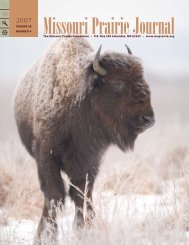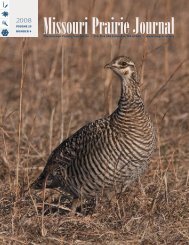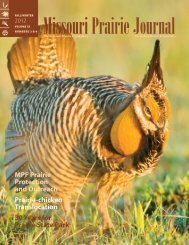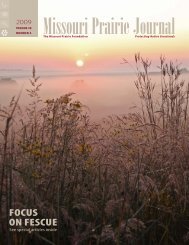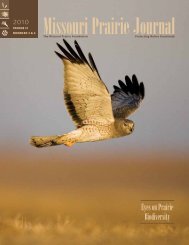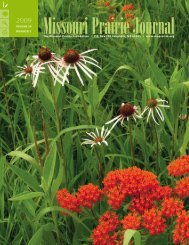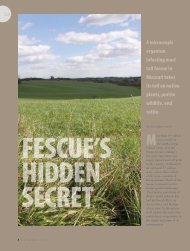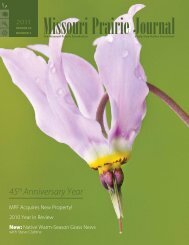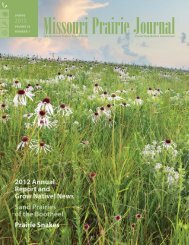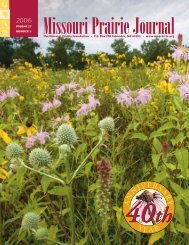Summer 2007: Volume 28, Number 3 - Missouri Prairie Foundation
Summer 2007: Volume 28, Number 3 - Missouri Prairie Foundation
Summer 2007: Volume 28, Number 3 - Missouri Prairie Foundation
- No tags were found...
You also want an ePaper? Increase the reach of your titles
YUMPU automatically turns print PDFs into web optimized ePapers that Google loves.
have seeded themselves into this garden, and Irefuse to weed them out, because they are notweeds. The most invasive plant here is NewEngland aster, and I welcome it. Some of thewildflowers that didn’t do well in the prairie haveflourished after they moved themselves into thegarden. Native plants have a talent for plantingthemselves in exactly the rightplace, and not just in termsof cultural requirements butalso in terms of design. Switchgrass seeded itself right at thecorner of the lily pool where itmakes a perfect accent. Swampaster (Aster puniceus) seededitself along the edge of thedeck where it sends up its largesprays of blue flowers in thefall. Maryland senna seededitself along a path where itsspikes of yellow pea flowers,and later, black seedpods, areperfectly displayed.I have learned that if Ihave a diversity of native plantsin the garden, no single speciescan threaten the others andweeding is unnecessary. WhenI was trying to grow roses,smartweed was an invasiveenemy that required sweatylabor to eliminate. Now when it appears in thegarden, it never gets out of control, and I canaccept it and appreciate its beauty. The Englishgarden is no longer perfectly groomed. In fact, itis scruffy and disheveled, but it makes a perfectwild bird garden. Stocked with a dozen feeders, itis full of birds year-round.In addition to increasing the ground covered,I have tried every year to increase the diversityof species, so there is considerable botanicalinterest here now. As of 2006, 186 prairie specieswere growing here. Of course some of thesenumbered only two or three specimens, butmany numbered in the hundreds.For some species, just addpatience: Last fall I collectedseed from these bottle gentiansand scattered it in wet areas.Five years from now, I’ll startlooking for its closed, bottleshapedblooms.When I first started growing prairie plantsI was surprised how quickly many developedinto big vigorous plants that would bloom thefirst year from seed. But I soon discovered thatsome species such as gentian, shooting star, wildhyacinth, and prairie trout lily were impossiblefor me to grow in the greenhouse. I did learn,however, that they could begrown into flowering plantsby simply scattering the seedand waiting five to eight years.I learned this first from thedowny gentian. After failing togrow this plant in the nursery,I scattered some seed in theprairie. Five years later, discoveringthe brilliant sapphireblue blooms of downy gentiannestled among the grasses wasone of the great joys of prairiegardening. These flowers are ofsuch superb quality you wouldthink they required the greatesteffort and skill to grow, butall they require is patience.Now I am concentratingon establishing rare andmore difficult species. Lastyear I bought three plants ofclosed or bottle gentian from<strong>Missouri</strong> Wildflowers Nursery(Mervin Wallace is a better nurseryman than I).Last fall I collected seed from the plants andscattered it in wet areas. Five years from now,I’ll start looking for its closed, bottle-shaped blueblooms. The pale gentian is well established here,using the same technique from a plant I boughteight years ago. This past spring I found morethan a hundred prairie trout lilies blooming here.These came from a handful of seed I collectedfrom a roadside prairie remnant eight years ago.Shooting stars and wild hyacinths are establishedhere using the same process of collecting andscattering seed and being patient.The prairie has turned me into somethingof a naturalist. During the last four years, I havetourJerry Brown is hostinga tour of his plantedprairie for MPF memberson September 29,from 1:30 to 5:00 p.m.,and a potluck dinnerwill be held from 5:00to 6:00 p.m. Pleasebring a side dish ordessert, your ownbeverage and a lawnchair. Hawk Point isin Lincoln County onstate route 47,11 miles north of theintersection of I-70and 47 at Warrentonand 8 miles west ofthe intersection of61 and 47 at Troy.Directions from thefour-way stop in HawkPoint: West on A 1.4miles to Turkey CreekRoad on right. Northon Turkey Creek 1 mileto Zalabak Road onleft. West on Zalabak0.3 mile to BluestemLane on right. North/west on Bluestem 0.5mile to #175 on right.RSVP to Jerry Brown,P.O. Box 212, HawkPoint, MO 63349,636-338-9298,jwb175@accessus.net.27




